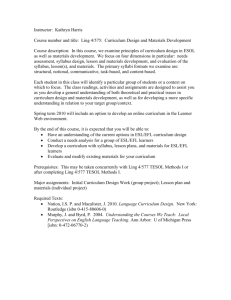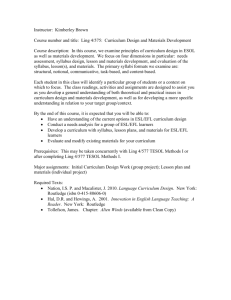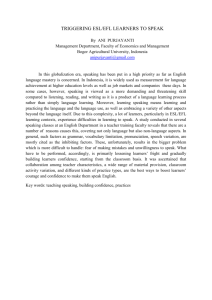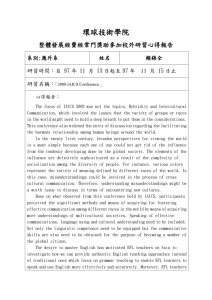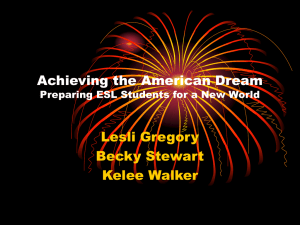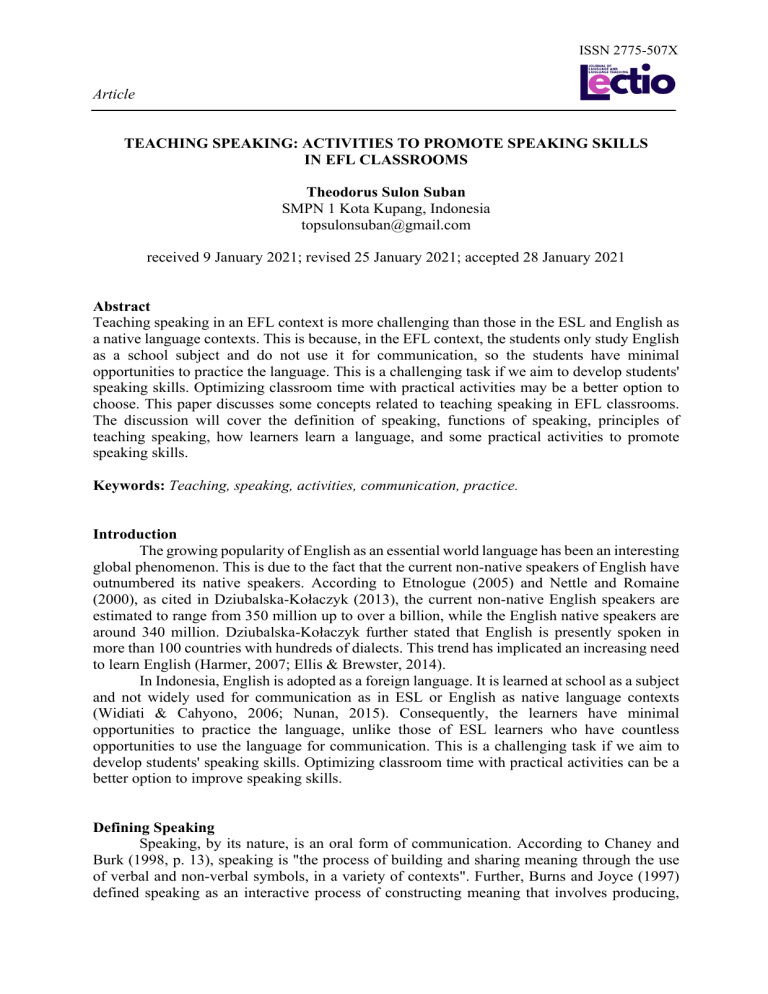
ISSN 2775-507X Article TEACHING SPEAKING: ACTIVITIES TO PROMOTE SPEAKING SKILLS IN EFL CLASSROOMS Theodorus Sulon Suban SMPN 1 Kota Kupang, Indonesia topsulonsuban@gmail.com received 9 January 2021; revised 25 January 2021; accepted 28 January 2021 Abstract Teaching speaking in an EFL context is more challenging than those in the ESL and English as a native language contexts. This is because, in the EFL context, the students only study English as a school subject and do not use it for communication, so the students have minimal opportunities to practice the language. This is a challenging task if we aim to develop students' speaking skills. Optimizing classroom time with practical activities may be a better option to choose. This paper discusses some concepts related to teaching speaking in EFL classrooms. The discussion will cover the definition of speaking, functions of speaking, principles of teaching speaking, how learners learn a language, and some practical activities to promote speaking skills. Keywords: Teaching, speaking, activities, communication, practice. Introduction The growing popularity of English as an essential world language has been an interesting global phenomenon. This is due to the fact that the current non-native speakers of English have outnumbered its native speakers. According to Etnologue (2005) and Nettle and Romaine (2000), as cited in Dziubalska-Kołaczyk (2013), the current non-native English speakers are estimated to range from 350 million up to over a billion, while the English native speakers are around 340 million. Dziubalska-Kołaczyk further stated that English is presently spoken in more than 100 countries with hundreds of dialects. This trend has implicated an increasing need to learn English (Harmer, 2007; Ellis & Brewster, 2014). In Indonesia, English is adopted as a foreign language. It is learned at school as a subject and not widely used for communication as in ESL or English as native language contexts (Widiati & Cahyono, 2006; Nunan, 2015). Consequently, the learners have minimal opportunities to practice the language, unlike those of ESL learners who have countless opportunities to use the language for communication. This is a challenging task if we aim to develop students' speaking skills. Optimizing classroom time with practical activities can be a better option to improve speaking skills. Defining Speaking Speaking, by its nature, is an oral form of communication. According to Chaney and Burk (1998, p. 13), speaking is "the process of building and sharing meaning through the use of verbal and non-verbal symbols, in a variety of contexts". Further, Burns and Joyce (1997) defined speaking as an interactive process of constructing meaning that involves producing, 42 LECTIO 1(1) receiving, and processing information. According to Burns and Joyce (1997), the forms and meaning of oral communication depend on the participants, and the purposes of speaking, and the context in which it occurs. To clarify the meaning, Harmer (2007) suggests using vocal paralinguistic features (varying voice's tone and volume) and physical paralinguistic features (facial expressions, gestures, and proximity). Functions of Speaking As an oral form of communication, speaking serves many functions. According to Brown and Yule (1983), speaking by its nature serves three main functions; talk as interaction, talk as a transaction, and talk as performance. Talk as Interaction Talk as interaction refers to the conversation. A conversation typically occurs when people meet, and when people converse, they exchange greetings, have small talk, recount their recent experiences to build friendship and strengthen their social relationship. According to Brown and Yule, talk as interaction is primarily spoken, reflecting role relationships, speakers' identities, and degrees of politeness. It may be formal or casual, and it uses conversational conventions, employs many generic words and conversational register, and is jointly constructed. Talk as Transaction Talk as a transaction refers to situations where negotiation of meaning occurs between interlocutors to reach a consensus. The focus of the talk is on what is said or done. The message and making oneself understood is the central focus. In such transactions, talk is associated with other activities. For example, students discuss a task and then report to the class or do something requested. Talk as a transaction focuses on information and message and not on the participants. The participants employ communication strategies to make themselves understood. Besides, the questions, repetitions, and comprehension checks are frequented, and negotiation and digression may occur as well. In talk as a transaction, however, linguistics accuracy is not always essential. Talk as Performance Talk as performance refers to public talk that transmits information before an audience, such as classroom presentations, public announcements, and speeches. It focuses on both message and audience, form and accuracy, and its organization and sequences are predictable. Also, its language is written-oriented and monologic. Principles in Teaching Speaking Teaching speaking in an EFL context differs from those in ESL and English as a native language contexts. Bailey (2015) acknowledged five fundamental principles of teaching speaking in an EFL context. Be Aware of the Difference between Second Language and Foreign-Language Learning Contexts The context of teaching speaking in ESL and EFL is different. In the ESL context, English is widely used for communication in the community, so the students have limitless Suban 43 opportunities to use English outside the classroom. Meanwhile, in the EFL context, English is only taught as a school subject and not used widely for communication. People who learn English in an EFL context may have specific purposes, for example, for business, education, etc. The status of English and the way it is taught is different from one country to another. EFL means differently to each country. It is for this reason an EFL teacher needs to consider global, national, and local contexts in his teaching. He/she needs to know how, when, and why his/her students use English. Give Students Practice Both Fluency and Accuracy Accuracy refers to applying good grammar rules, clear pronunciation, and appropriate choice of vocabulary. Fluency includes speaking at acceptable speed with few false starts and hesitations. When dealing with accuracy, it is vital to correct pronunciation, vocabulary, and sentence structure, either by interrupting the speaker or noting errors and providing feedback on them after the speaker has finished. When coaching for fluency, it is important to motivate students to bravely express out the meaning without worrying about making errors or mistakes. The crucial point is that the meaning is understood. Provide Opportunities for Students to Talk by Using Group Work or Pair Work and Limiting Teacher Talk In the EFL context, students have limited opportunities to speak the language outside the class; hence classroom time is the best time for practice. To use classroom time efficiently and effectively, pair work and group work are the best options (Ur, 2012). By this strategy, students' talking time increases, and teacher talking time decreases. If pair and group work run well, they can maximize opportunities for students to negotiate meaning, engage in genuine conversation, and learn to take turns. Speaking as a social activity is cultivated as well. Plan Speaking Tasks that Involve Negotiation of Meaning This kind of task aims to trigger students to learn to clarify meaning. Since misunderstanding often occurs in communication, learners need to learn how to clarify the meaning or how to ask people for meaning clarity. For this reason, more tasks on misunderstanding are designed to stimulate students to apply this communication strategy as one of the communicative competence components. Design Classroom Activities that Involve Guidance and Practice in Both Transactional and Interactional Speaking Halliday noted that spoken language has three main functions. First, it is used to obtain goods and services. Hence, it is called transactional. Second, it is used to socialize; therefore, it is interactional. Lastly, it is used for pleasure. The first and second functions dominate our daily language use; thus, they should be built into our teaching. Nunan tends to use the term interpersonal to replace the term 'interactional' because interactional is social. Also, transactional is essentially interactional as well. Guidance and practice on these functions enrich students with a great variety of language use and communication context. How Learners Learn A Language Before Communicative Language Teaching (CLT) was incepted, language learning focused mainly on grammatical competence mastery, and language learning was much seen as a habit formation process. Good habits of creating correct sentences and mistake-free language use are formed. Errors making was avoided through controlled exercises, memorizing 44 LECTIO 1(1) dialogues, and performing drills. Learning in this paradigm was seen mostly as an error-free language practice under the teacher's control (Richards, 2005). However, after CLT was introduced, the paradigms of language learning have changed significantly. Language learning is then seen as the process of interaction between the learners and the language users, and the meaning is collaboratively created. Besides, the language is a medium to create meaningful and purposeful interaction. Understanding is built through meaning negotiation between interlocutors. Also, language learning is facilitated by feedback provision, language exposure, and meaning-focused input. Other dimensions of language learning lie in the learners' attempt to integrate new forms into their developing communicative competence, trying out and experimenting with different ways of saying things (Richards, 2005). These new paradigms implicate on teacher's role. The teacher no longer focuses merely on identifying mistakes and errors the students make but scaffolds the learners to achieve what Vygotsky called "Zone of Proximal Development" (ZPD). Making mistakes and errors in this part is seen as normal. Furthermore, the teacher plays the role of an English speaker model in terms of accuracy and fluency. Learning in these paradigms gives learners more opportunities to take control of their learning to some extent and demonstrate their freedom and creativity in practicing the language. Making mistakes and errors is no longer regarded as defamation, so it should be avoided. However, it is seen as an integral part of learning. Besides, interaction as a social dimension of language learning is also fostered. To engage students in speaking class activities, the teacher may play roles as a prompter, a participant, and a feedback provider. As a prompter, the teacher reminds and directs students to be on the right track doing intended activities and prevent them from losing orientation and doing unexpected things. Meanwhile, as a participant, the teacher takes part in role-playing, discussion, introducing new information, ensuring students' continuing participation, and maintaining a conducive atmosphere. As a feedback provider, the teacher gives students feedback to appreciate what went well, identify what went wrong, and provide further scaffolding and motivation (Harmer, 2007). Practical Activities to Promote Speaking Skills There are numerous activities to do in speaking class. It is the teacher's authority to decide which activity to perform. Some aspects commonly considered in choosing an activity are students' language proficiency level, specific learning goals, and resource availability. This consideration may help to ensure that the activity being chosen is useful. The following are some practical activities commonly done in speaking class. Dialogue Dialogue is a basic form of oral communication (Celce-Murcia, 2001). In language learning, a dialogue is used for practicing language functions such as greetings, leave-takings, thanking, agreeing, asking for help, offering help, asking for attention, showing attention, and asking for information. In classroom practice, students are given a text script. The students then memorize it and then perform it in pairs or groups (Nation, 2014). The dialogue can occur several times in various ways, moods, roles, imaginary situations, and contexts (Ur, 2012). The students can perform it either very slowly, happily cheerfully, or very fast. They may play the roles of a teacher and a young student, or as a popular figure. At a later stage, students can play variations of roles, moods, and ways and add to the texts. Suban 45 This practice reflects how real communication is. That variations of roles, moods, and ways, and text construction are common in real-life situations. Students need to be aware of it and learn to get used to it. For some people, this technique may be assumed outdated and ineffective; however, it is extremely beneficial for developing oral fluency at elementary levels. It provides the students with ready-made meaningful exchanges to perform fluently and give them the confidence early to communicate successfully in spoken English. Further, Natkare (2015) points out that a good conversation needs delicacy, tact, give, and take. To achieve these qualities, a speaker may allow his or her conversation partner to speak, respect the other person’s point of view, concentrate on the conversation, find out what the listener wants by asking, and listen to the responses. Also, a speaker needs to define terminology to minimize misunderstanding, maintain a cordial and friendly atmosphere, and willing to clarify any misunderstandings and solve problems. Surveys One of the exciting techniques to provoke conversation and opinion exchange among students is through conducting questionnaires and surveys (Harmer, 2008). British Council (n.d) noted that doing surveys in the class can be a fruitful way of getting students to interact, produce question forms, and collect, analyze real information. This technique will be more useful if the students plan questionnaires themselves. It is recommended that the survey should be better built around the topic that the students have learned because the topic will function as the input for students to design the survey. The input will help students activate all their language knowledge and generate new ideas in designing the survey. Besides, the students will find the natural use of language much more meaningful. Before designing the survey, the teacher may pre-teach the words and tell stories related to the topic. By so doing, the students are exposed to more vocabulary and ideas. After that, the students sit in pairs to plan their survey questions. After constructing the questions, the students go around the class to question other students and note their responses. During this activity, the teacher listens and prompts when necessary. When the survey is finished, the students voluntarily share their exciting experiences while conducting the survey. The teacher needs to introduce types of survey questions such as open-ended and close-ended questions. The survey technique has some benefits. Firstly, it varies the classroom structure periods from teacher-centered to learner-centered. The students develop ideas into survey questions with the help of the teacher. Here, the students have more time to talk than the teacher. Secondly, it allows students to move around (physical movement) the class rather than sitting for long hours. Lastly, it promotes a welcome variety of interactions. Current and popular issues, such as smoking, mobile phone use, transport, feelings and emotions, musical preferences, can be interesting topics to be developed into surveys and questionnaires. Picture Description One way of provoking conversation is to get students to describe pictures. CanningWilson (1999) stressed that picture use in EFL class is beneficial for some reasons. Firstly, research shows that imagery facilitates learning. When a picture is accompanied by text, it can drive the learner to think about the language being learned more fully. Secondly, visual images permit us to infer, deduce information from a variety of sources. Also, pictures can bring the outside world into the classroom. Students can perceive the outside world through pictures. 46 LECTIO 1(1) To begin with, the class is divided into some groups. Each group gets chances to describe several pictures. The pictures are described in succession. When describing a picture, the picture is displayed so all its members can see it. They have two minutes to say as many sentences as possible to describe the picture; a secretary puts a tick on a piece of paper every time the group says the sentence that correctly describes the details of the picture. After two minutes of talking, the group reports how many ticks they have. The group then continues to describe the next pictures following the steps mentioned above. This technique encourages the reluctant student to speak in groups, and each member may take part in practice speaking. According to Ur (2012), this technique is simple but surprisingly productive for elementary or low-intermediate classes. The simplicity of the task facilitates students to succeed in it and boosts students' confidence to compete for the next time around. The use of picture description assists students in developing their coherent speaking and oral fluency (Phuong, 2018; Romero Márquez, 2020). Picture Differences Variation to picture description is picture description. This activity is performed in pairs. This activity aims to find out the differences in each picture. To begin with, each student is given a different picture. They then identify the pictures, highlight the details that appear on the pictures. After identifying, each student compares his/her answer with his/her pair's. They identify, compare, and contrast the two pictures. This activity "produces plenty of purposeful question–and–answer exchanges. The necessary vocabulary is specific and likely predictable, so it is suggested to discuss and write up these items in advance on the board (Ur, 2012). The possible problem to anticipate here is a temptation to cheat the partner's picture. Therefore, during this activity, the teacher monitors students and prevent them from cheating. When students get stuck, the teacher provides prompts or drops hints to pairs. This activity helps students forge their higher-order thinking skills, particularly in comparing and contrasting things. Canning-Wilson (1999, p. 6) suggested that pictures used in this technique should be able to be interpreted to the point, demonstrate reasonable judgment, and enhance learning, sensory acuteness, and testing situation as a whole. Furthermore, the pictures should help to clarify the gist of the message, elicit parts of speech with or without a context, and do not indicate violent acts, and not appear overcrowded, stereotype in any form or offer too many distractors. Information Gap Information gap is an interactive technique in language learning. Communicative language learning emphasizes the need for meaningful communication; thus, when the students have a genuine reason to talk, they will learn to use the language more effectively (Goh, 2007). Information gap offers an activity that stimulates students to interact to get the intended information to complete a task (Harmer, 2007). Using this technique, the students are paired (sometimes also grouped), and both partners are given the same text with different missing parts. To obtain the missing information, both partners need to interact using relevant language without looking at each other's text because each of them has the information another does not have. By the end of the interchange, both sides in possession of the total amount of information. Types of Information Gap Using an information gap activity in language learning is exciting and communicative since each participant seeks to find specific information from his/her partner. According to Harmer (2007) and Li (2015), an information gap can be used to solve a puzzle, describe and Suban 47 draw a picture, and describe and draw a picture, particularly for putting things in the right order. Also, it can be used to find similarities and differences between pictures and to reconstruct a story. To make information gap activities more productive, Li (2015, p. 173) recommended several tips. First, preparation. Students need to be prepared to build questions and responses. Students may be better presented with controlled information gap exercises at earlier stages and then move on to freer information gap exercises in the later stages. Second, pre-teaching vocabulary. To avoid being interrupted during task completion, the teacher needs to pre-teach the keywords beforehand. Third, clear instruction. Before the task is given, the teacher should ensure the instructions are crystal clear to students. The teacher can explain the instructions in students' native language if they do not understand the instructions in the target language. Fourth, demonstration. To strengthen students' understanding and mastery of the task, the teacher can model the task first. By modeling, the students see and learn how the task is performed. Fifth, Mixed ability. Mixed ability in EFL class is common in nature. Some students may have intermediate proficiency, while others are at the beginning level. To handle this situation, the teacher can foster cooperative learning; in that the students are willing to exchange information and offer help. Lastly, the teacher's role. After setting up the activity, the teacher can observe if each student is on the right track performing the activity. The teacher writes down problems or errors being faced by students and notes them for later attention. On the spot, correction should be minimized to avoid students perceiving the correction activity unwelcome. Role Play Role-play is one of the most common speaking class activities (Azies & Alwasilah, 1996; Ur, 2012). Role-plays are crucial in the Communicative Approach since they provide students opportunities to practice communicating in different social contexts and different social roles (Larsen-Freeman & Anderson, 2013). Further, Larsen-Freeman and Anderson classify role plays into very structured role-play and less structured role play. In the very structured role-play, students are given a text describing the characters and setting. The students then memorize the text. After that, the students act out the role. This kind of role-play is suitable for beginners. Meanwhile, in less structured role-play, the teacher tells the students the characters they perform, describes the setting and introduces the topic they will talk about, but they decide what they say. Here, the students produce the language by themselves and demonstrate their improvisation based on a scene. For example, a student plays the role of a police officer, and another student is a bus driver based on a topic and specific situation (Nation, 2014). Alternatively, in other sessions, the teacher can give students opportunities to create another narration, share ideas to generate a scenario or dialogue. The less structured role play is in line with the Communicative Approach’s notion because it provides students with more choice. This kind of role-play is suitable for students with intermediate proficiency. Role-play technique also gets reluctant or shy students to speak. Additionally, it fosters class interaction. Each student can learn from one another (peer teaching). During the role-play, the teacher can function either as a facilitator, a spectator, or a participant. As a facilitator, the teacher provides feedback or new language, particularly during rehearsal time. Meanwhile, as a spectator, the teacher watches role play and offers comments and advice at the end. Furthermore, as a participant, the teacher gets involved in the role play. Here, the teacher can act as the model for speaking accuracy, fluency, and expressions. 48 LECTIO 1(1) Story Completion Story completion is an engaging and enjoyable activity in speaking class. In using this technique, the students sit in a circle. The teacher starts to narrate a story, but after a few sentences, the teacher stops telling the story. Each student then takes a turn to continue narrating the story in four to ten sentences. Students can add new characters, events, descriptions to develop a story. In this way, the students build their confidence, interest and improve their speaking skills (Rifa'at & Suryani, 2018; Hidayati et al., 2019; Hamsia, 2018). This technique provides students opportunities to generate their imagination and creative thinking in a relaxed way. The students are also encouraged to make meaning and construct their point of view on a story (Gravett, 2019). Here, the student's voice is heard in the class. Hukom (2019) noted that story completion brings excitement and promotes equality in the classroom. Each student gets an equal opportunity to contribute to building up a story in a less intimidating activity. Storytelling Storytelling or telling the story is very useful for developing students' vocabulary and pronunciation and helps students develop their thinking skills and imagination (Cameron, 2001). According to Atta-Alla (2012), storytelling helps develop integrated language skills at once; listening, speaking, reading, writing, interactional, vocabulary, and literacy. The students essentially retell a story that they have read or heard in their own words. When narrating a story, the students, first of all, remember the story, then reconstruct the memory, ideas, and then internalize them. After that, the students narrate it. Sometimes body language expressions are used to make the story more vivid. The utterances are also varied in terms of volume, dynamics, rhythm, intonation, and body language expression to drive the message more powerful. According to the British Council (n.d.), a student can get some benefits at once when narrating a story. First, it increases verbal fluency. Second, it generates imagination and creativity. Third, it promotes a feeling of well-being and relaxation. Fourth, it allows students to explore their cultural roots and allow children to experience diverse cultures, and lastly, it helps students understand how wisdom is common to all cultures. Two key actions performed in storytelling are remembering the story and telling the story's plots. When remembering the story, the storyteller collects ideas and then reconstructs them into a coherent and cohesive text. After that, the storyteller begins telling the story. To captivate the audience during storytelling, British Council (n.d) suggests the following performance techniques. First, making the plot map to ease memory. Second, drawing a story structure to help remember the key events. Third, the student tells the story to himself or herself before telling the story to an audience. Next, practicing telling stories numerous times before performing in front of an audience, and lastly, adapt and improvise the stories to drive creativity. To make the story vivid and exciting, a storyteller needs to develop the performance skills in varying the voice volume, pitch, and tempo, using body language (facial expression, gestures), maintaining eye contact with the audience or listeners, having a clear focus and maintaining concentration, using different and exaggerated character voices, and using silence and pause to add dramatic effect. According to Nation (2014), all these speaking activities will work best when repeated in proper space, whether in weeks or months. The more repetitions are done, the better retention is achieved. The effect of repetition will be strengthened when the quality of attention is added to each repetition. Suban 49 Conclusion As discussed previously, learning English in an EFL context is different from those in ESL and English as native language contexts because, in the EFL context, English is only learned as a school subject and not used for communication. Consequently, the students have minimal opportunities to practice it, unlike those in ESL and English as native language contexts who have limitless opportunities to practice and use the language for communication. This is a challenging task if we aim to develop our students' speaking skills. Optimizing classroom time with appropriate learning activities can be a better choice. Practical activities such as dialogue, surveys, picture description, picture differences, role plays, story completion, and storytelling can be fun and formative to promote students' speaking skills. It is the teacher's authority to decide which activity to perform based on students' language proficiency level, learning goals, and resource availability, so the chosen activity is useful. References Atta-Alla, M. N. (2012). Integrating language skills through storytelling. English Language Teaching, 5(12), 1-13. https://doi.org/10.5539/elt.v5n12p1 Aziez, F., & Alwasilah, A. C. (1996). Pengajaran bahasa komunikatif: Teori dan praktek. PT Remaja Rosdakarya. Bailey, K. M. (2003). Speaking. In Nunan, D. (Ed.), Practical English language teaching (pp. 47-66). McGraw-Hill/Contemporary. British Council. (n.d.). Storytelling - benefits and tips. Retrieved July 17, 2020, from https://www.teachingenglish.org.uk/article/storytelling-benefits-tips British Council. (n.d.). A class survey. Retrieved July 20, 2020, from https://www.teachingenglish.org.uk/article/a-class-survey Brown, G., & Yule, G. (1983). Teaching the spoken language (Vol. 2). Cambridge university press. Burns, A., & Joyce, H. (1997). Focus on Speaking. Macquire University Press Cameron, L. (2001). Children learning a foreign language.Teaching languages to young learners. Cambridge university press. Canning-Wilson, C. (1999). Using pictures in EFL and ESL classrooms. The Current Trends in English Language Testing Conference. https://eric.ed.gov/?id=ED445526 Celce-Murcia, M. (2001). Language teaching approaches: An overview. Teaching English as a second or foreign language. Heinle & Heinle. Chaney, A. L., & Burk, T. L. (1998). Teaching oral communication in grades K-8. Allyn and Bacon. Dziubalska-Kołaczyk, K. (2013). English or ELFish? A teaching dilemma of the 21st century. In Migdał J., & Piotrowska-Wojaczyk A. (Eds.), Cum reverentia, gratia, amicitia…: Księga jubileuszowa dedykowana Profesorowi Bogdanowi Walczakowi (pp. 463-469). Wydawnictwo Rys. http://wa.amu.edu.pl/kdk/sites/default/files/English_or_ELFish_paper.pdf Ellis, G., & Brewster, J. (2014). Tell it again! The storytelling handbook for primary teachers (3rd ed.). British Council. https://www.teachingenglish.org.uk/sites/teacheng/files/pub_D467_Storytelling_handb ook_FINAL_web.pdf Goh, C. C. M. (2007). Teaching speaking in the language classroom. SEAMEO Regional Language Centre. 50 LECTIO 1(1) Gravett, K. (2019). Story completion: Storying as a method of meaning-making and discursive discovery. International Journal of Qualitative Methods, 18, 1677–1697. https://doi.org/10.1177%2F1609406919893155 Hamsia, W. (2018). Developing students’ speaking ability through story completion. Journal of English Language Teaching, 5(1), 57-64. https://doi.org/10.33394/jo-elt.v5i1.2298 Harmer, J. (2007). The practice of English language teaching (4th ed). Pearson Education Limited. Hidayati, Puspitasari, I., & Hafidah, A. S. (2019). The implementation of story completion technique in students’ speaking skill to the tenth graders of SMKN 1 Pacitan in the academic year of 2018/2019 [Undergraduate thesis, STKIP PGRI Pacitan]. Repository STKIP PGRI Pacitan. http://repository.stkippacitan.ac.id/id/eprint/56 Hukom, S. J. (2019). Story completion: A technique in teaching speaking. Jurnal Tahuri, 16(2), 1-9. https://doi.org/10.30598/tahurivol16issue2page1-9 Larsen-Freeman, D., & Anderson, M. (2013). Techniques and principles in language teaching (3rd ed.). Oxford university press. Li, X. (2015). The application of the information-gap principle in promoting English language skills in college English teaching. First International Conference on Information Science and Electronic Technology (ISET 2015). Atlantis Press. https://dx.doi.org/10.2991/iset-15.2015.43 Natkare, B. (2015). Language skills in formal and informal conversation. LangLit, 1(4), 337342. Nation, P. (2014). What do you need to know to learn a foreign language. Victoria University of Wellington. https://www.wgtn.ac.nz/lals/resources/paul-nations-resources/paulnations-publications/publications/documents/foreign-language_1125.pdf Nunan, D. (2015). Teaching English to speakers of other languages: An introduction. Routledge. Phuong, B. H. (2018). Can using picture description in speaking sessions help improve EFL students’ coherence in speaking?. European Journal of Foreign Language Teaching, 3(3), 33-51. http://dx.doi.org/10.46827/ejfl.v0i0.1794 Richards, J. C. (2005). Current trends in communicative language teaching. Communicative language teaching today. SEAMEO Regional Language Centre. https://www.professorjackrichards.com/wp-content/uploads/Richards-CommunicativeLanguage.pdf Rifa’at, A. A., & Suryani, N. Y. (2018). Please complete the story: Story completion technique in teaching speaking to non-English major students. Language and Education Journal, 3(2), 1-13. http://ejournal.uniski.ac.id/index.php/LEJ/article/view/40 Romero Márquez, A. V. (2020). Picture description to enhance oral production in young EFL learners [Master's thesis, Universidad Casa Grande]. Repositorio Digital Universidad Casa Grande. http://dspace.casagrande.edu.ec:8080/bitstream/ucasagrande/2276/1/Tesis2451ROMp. pdf Ur, P. (2012). A course in English language teaching. Cambridge University Press. Widiati, U., & Cahyono, B. Y. (2006). The teaching of EFL speaking in the Indonesian context: The state of the art. Bahasa dan Seni, 34(2), 269-292. http://sastra.um.ac.id/wpcontent/uploads/2009/10/The-Teaching-of-EFL-Speaking-in-the-Indonesian-ContextThe-State-of-the-Art-Utami-Widiati-Bambang-Yudi-Cahyono.pdf

